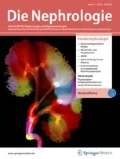Zusammenfassung
Multimorbide, ältere Dialysepatienten vertragen Hämodialysebehandlungen oft schlechter als jüngere. Typische Komplikationen sind intradialytische Hypotonie, Krämpfe, Vorhofflimmern und Abgeschlagenheit nach der Dialyse, die zu einem beschleunigten Verlust der Selbständigkeit in dieser Patientengruppe führen. Ätiologisch spielt eine verminderte Toleranzbreite gegenüber intradialytischen Schwankungen des Intravasalvolumens eine bedeutende Rolle. Diese ist bedingt durch eine Einschränkung physiologischer hämodynamischer Anpassungsmechanismen in Kombination mit einer urämischen und/oder diabetischen autonomen Neuropathie. Die daraus resultierenden relevanten Einschränkungen der Organperfusion in Darm, Leber, Nieren, Herz und Hirn tragen direkt zur Entstehung von Inflammation, Malnutrition, Herzinsuffizienz, Gebrechlichkeit, Depression und Demenz bei. Um diese fatalen Komplikationen bei älteren Dialysepatienten zu vermeiden, muss die Hämodialyseverordnung in zahlreichen Facetten an die Empfindlichkeit der multimorbiden älteren Patienten individuell angepasst werden.
Abstract
Elderly dialysis patients with multiple comorbidities often have poorer tolerance to hemodialysis treatment than younger patients. Typical complications, such as intradialytic hypotension, cramps, atrial fibrillation and post-dialysis fatigue contribute to a rapid loss of independence in this vulnerable patient population. The underlying etiology is a reduced tolerance to intravascular volume changes during dialysis, which is caused by impaired cardiovascular hemodynamic responses in combination with uremic and/or diabetic autonomous neuropathy. Significant reduction in organ perfusion occurring in the intestines, liver, kidneys, heart and brain contribute to the development of inflammation, malnutrition, heart failure, frailty, depression and dementia. To protect vulnerable elderly dialysis patients from these fatal complications of intradialytic tissue hypoxia, the prescription of hemodialysis needs to be individually adjusted in numerous aspects to the sensitivities of multimorbid elderly patients.

Literatur
Berger JR, Hedayati SS (2012) Renal replacement therapy in the elderly population. Clin J Am Soc Nephrol 7:1039–1046
Burton JO, Jefferies HJ, Selby NM et al (2009) Hemodialysis-induced repetitive myocardial injury results in global and segmental reduction in systolic cardiac function. Clin J Am Soc Nephrol 4:1925–1931
Campos I, Chan L, Zhang H et al (2016) Intradialytic hypoxemia in chronic hemodialysis patients. Blood Purif 41:177–187
Causland FR, Tilley BS, Waikar SS (2012) Dialysate sodium and the milieu intérieur. Clin J Am Soc Nephrol 7:5–7
Chang YM, Shiao CC, Chang KC, Chen IL, Yang CL, Leu SC, Su HL, Kao JL, Tsai SC, Jhen RN (2015) Heart rate variability is an indicator for intradialytic hypotension among chronic hemodialysis patients. Clin Exp Nephrol. doi:10.1007/s10157-015-1189-9
Chaveau P, Combe C, Laville M et al (2001) Factors influencing survival in hemodialysis patients aged older than 75 years: 2.5-year outcome study. Am J Kidney Dis 37:997–1003
Eldehni MT, Odudu A, McIntyre CW (2015) Randomized clinical trial of dialysate cooling and effects on brain white matter. J Am Soc Nephrol 26:957–965
Flythe JE, Kimmel SE, Brunelli SM (2011) Rapid fluid removal during dialysis is associated with cardiovascular morbidity and mortality. Kidney Int 79:250–257
Jassal SV, Trpeski L, Zhu N, Fenton S, Hemmelgarn B (2007) Changes in survival among elderly patients initiating dialysis from 1990 to 1999. CMAJ 177:1033–1038
Jassal SV, Chiu E, Li M (2008) Geriatric hemodialysis rehabilitation care. Adv Chronic Kidney Dis 15:115–122
Jassal SV, Chiu E, Hladunewich M (2009) Loss of independence in patients starting dialysis at 80 years of age or older. N Engl J Med 361:1612–1613
Kurella TM, Covinsky KE, Chertow GM et al (2009) Functional status of elderly adults before and after initiation of dialysis. N Engl J Med 361:1539–1547
McIntyre CW, Crowley L (2016) Dying to feel better: the central role of dialysis-induced tissue hypoxia. Clin J Am Soc Nephrol 11:549–551
McIntyre CW, Goldsmith DJ (2015) Ischemic brain injury in hemodialysis patients: which is more dangerous, hypertension or intradialytic hypotension? Kidney Int 87:1109–1115
McIntyre CW, Harrison LE, Eldehni MT et al (2011) Circulating endotoxiemia: a novel factor in systemic inflammation and cardiovascular disease in chronic kidney disease. Clin J Am Soc Nephrol 6:133–141
Mustafa RA, Bdair F, Akl EA et al (2016) Effect of lowering the dialysate temperature in chronic hemodialysis: A systematic review and meta-analysis. Clin J Am Soc Nephrol 11:442–457
Patel N, Hu SL (2015) Preserving residual renal function in dialysis: what we know. Semin Dial 28:250–258
Rubinger D, Revis N, Pollak A et al (2004) Predictors of haemodynamic instability and heart rate variability during haemodialysis. Nephrol Dial Transplant 19:2053–2060
Sands JJ, Usvyat LA, Sullivan T, Segal JH, Zabetakis P, Kotanko P, Maddux FW, Diaz-Buxo JA (2014) Intradialytic hypotension: Frequency, sources of variation and correlation with clinical outcome. Hemodial Int 18:415–422
Spiegel DM (2012) Avoiding harm and achieving optimal dialysis outcomes – the dialysate component. Adv Chr Kidney Dis 19:166–170
Stefannson BV, Brunelli SM, Cabrera C et al (2014) Intradialytic hypotension and risk of cardiovascular disease. Clin J Am Soc Nephrol 9:2124–2132
Wang AY, Ninomiya T, Al-Kahwa A et al (2014) Effect of hemodiafiltration or hemofiltration compared with hemodialysis on mortality and cardiovascular disease in chronic renal failure: A systematic review and meta-analysis of randomized trials. Am J Kidney Dis 63:968–978
Wong J, Vilar E, Davenport A, Farrington K (2015) Incremental hemodialysis. Nephrol Dial Transplant 30:1639–1648
Author information
Authors and Affiliations
Corresponding author
Ethics declarations
Interessenkonflikt
F. Aregger und M.K. Kuhlmann geben an, dass kein Interessenkonflikt besteht.
Dieser Beitrag beinhaltet keine von den Autoren durchgeführten Studien an Menschen oder Tieren.
Additional information
Redaktion
C. Erley, Berlin
W. Kleophas, Düsseldorf
Rights and permissions
About this article
Cite this article
Aregger, F., Kuhlmann, M.K. Hämodialyse bei Älteren. Nephrologe 11, 320–327 (2016). https://doi.org/10.1007/s11560-016-0084-z
Published:
Issue Date:
DOI: https://doi.org/10.1007/s11560-016-0084-z

